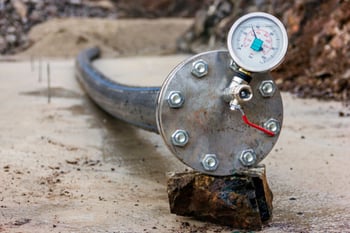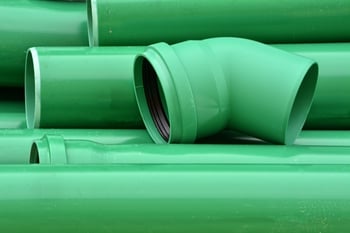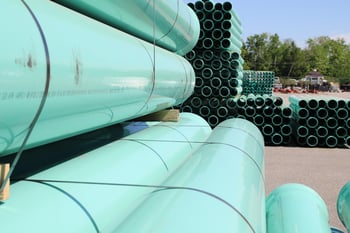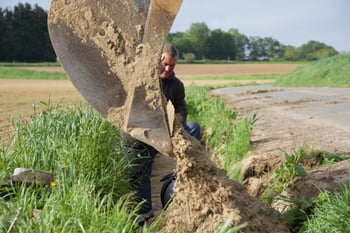Strength, Durability and Economy - Your SDR35 PVC Guide
- Home
- Team EJP Blog
- Strength, Durability and Economy - Your SDR35 PVC Guide
- Feb 14, 2019 9:27:11 AM
- Everett J. Prescott
*Updated May 22, 2020 - Previous Title: Are You Using SDR35 PVC Sewer Pipe for Your Wastewater Applications?
Wastewater lines can be a real headache. If they're not somewhat flexible at the joints, they can have issues when cold weather and frost heaves cause the pipes to displace. If that happens, you can end up with some serious problems with sewer leakage and potential contamination of ground and surface water supplies. Fortunately, there's a better option than standard PVC; SDR35 PVC sewer pipe. Here's a bit more on this flexible, solid-sealing option and how it can benefit your water utility in the field.
Flexible Strength:
The flexible, locked-in elastomeric ring creates a tight seal between pipes while still allowing for movement between the pipes. That means if you deal with expansion, contraction, vibration, or other motion over and around your pipes, they'll stay sealed properly without any leakage problems to the surrounding environment.
Pressure Resistant:
 Though not used for pressurized lines, the SDR35 PVC sewer pipe system has been tested to the ASTM D3219 standard, providing you with a solid seal. This standard ensures that the system can bear up to a 25-foot head pressure test, as well as a 22" Hg vacuum, providing strong performance even in the most extreme weather conditions.
Though not used for pressurized lines, the SDR35 PVC sewer pipe system has been tested to the ASTM D3219 standard, providing you with a solid seal. This standard ensures that the system can bear up to a 25-foot head pressure test, as well as a 22" Hg vacuum, providing strong performance even in the most extreme weather conditions.
Buh-Bye Sealants:
Why bother with messy cement? The ring gasket system allows for a very simple connection and installation process. With a simple push to press the inner pipe past the gasket, the entire system is locked in place, sealed against leakage and ready to go. There's no waiting for sealants to cure or slathering on cement to create a seal in poor weather.
Integrated Durability:
The bell on the pipe is an integral part of the overall PVC matrix, making it just as strong as the rest of the system. The spigot ends are pre-beveled in the factory, making it easy to quickly get the other end of the pipe to slide neatly into place and quickly line up with the integrated ring gasket system.
Easy Installation:
 The light weight of SDR35 PVC pipe makes it very easy to get it into place with virtually no real lifting involved. It's easy to cut with your existing tools, just like standard PVC, such as a hacksaw or power saw, and is simple to bevel in the field to quickly get that same, easy-to-install process as you would with pre-finished ends.
The light weight of SDR35 PVC pipe makes it very easy to get it into place with virtually no real lifting involved. It's easy to cut with your existing tools, just like standard PVC, such as a hacksaw or power saw, and is simple to bevel in the field to quickly get that same, easy-to-install process as you would with pre-finished ends.
SDR35 PVC Sewer Pipe Is A Solid Investment:
Like other PVC pipe systems, SDR35 PVC sewer pipe is resistant to a great many chemicals and environments, making it a great long-term choice for your water utility's infrastructure investment projects. It works well with corrosive environments, sewer gas, sulfuric acid, alkaline compounds, and acidic soils. At the same time, it is very resistant to scouring, abrasions, and gouging.
How to Install SDR35 PVC:
As we mentioned, installing SDR35 PVC is easy to install. The trench width will be between 1.2 to 2.9 times the diameter of the pipe with a minimum trench width of 18", leaving a minimum of 6" on either side of the pipe to the trench wall. The use of trench boxes is encouraged for worker safety and the bottom of the trench should be smooth, bedded with crushed stone or coarse sand and compacted prior to installation.
 The pipe should be placed in the trench, not dropped. If a piece of pipe must be cut to length, it's important that the cut be square to ensure that the end will seal uniformly at the gasket. Before cutting, measure the distance from the end of the pipe to the insertion depth line or marker, then transfer the line onto the cut pipe once the cut is complete. Any soil or foreign matter that gets into the pipes should be removed prior to coupling.
The pipe should be placed in the trench, not dropped. If a piece of pipe must be cut to length, it's important that the cut be square to ensure that the end will seal uniformly at the gasket. Before cutting, measure the distance from the end of the pipe to the insertion depth line or marker, then transfer the line onto the cut pipe once the cut is complete. Any soil or foreign matter that gets into the pipes should be removed prior to coupling.
The gasket, inside of the bell and the spigot area should all be cleaned with a brush, paper towel or cloth to remove foreign matter, soil and similar material. Check the gasket and sealing surfaces to inspect for deformation or damage that may impact the coupling's ability to seal properly. For solid-wall sewer pipe, you'll only lubricate the spigot end of the pipe, while for Kor-Flo-style pipe, you'll only lubricate the interior of the bell. Always use either a lubricant that is provided by the manufacturer or one that they approve
Once the pipe is lubricated, align the bell and spigot, then insert the spigot into the bell until the gasket is contacted uniformly. The insertion depth is marked on the outside by a stop mark or assembly stripe to help you reach the proper depth. Do not insert the pipe past this mark, as doing so could void your manufacturer's warranty.
 Material should be added to the trench to keep the pipe from moving horizontally or vertically during the backfilling process. Once it's securely in place, you should add the first layer of backfill, which should cover the pipe to the diameter of the pipe, followed by a secondary layer of backfill that brings the level of fill up to the surface, mounding over slightly to account for settling.
Material should be added to the trench to keep the pipe from moving horizontally or vertically during the backfilling process. Once it's securely in place, you should add the first layer of backfill, which should cover the pipe to the diameter of the pipe, followed by a secondary layer of backfill that brings the level of fill up to the surface, mounding over slightly to account for settling.
SDR35 PVC delivers strong results without a lot of extra time, effort or cost, while delivering long-term benefits for your water utility. When it comes to providing you with the best possible products and services for your water utility's needs, EJ Prescott has the answers you need. Dedicated to serving the water utility industry, we only provide our customers with the best products tested in-house by Team EJP for longevity, durability, and ease of use. Please feel free to contact one of our experienced associates today to learn more about SDR35 PVC pipe, with any questions or to place an order.








